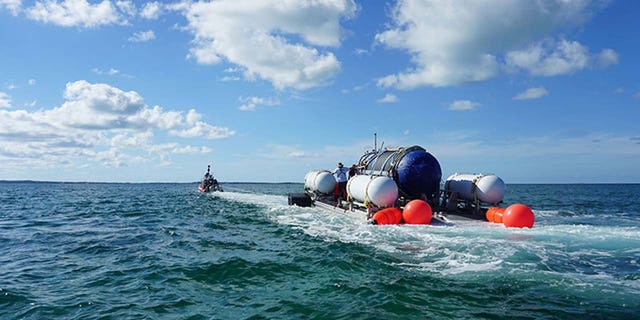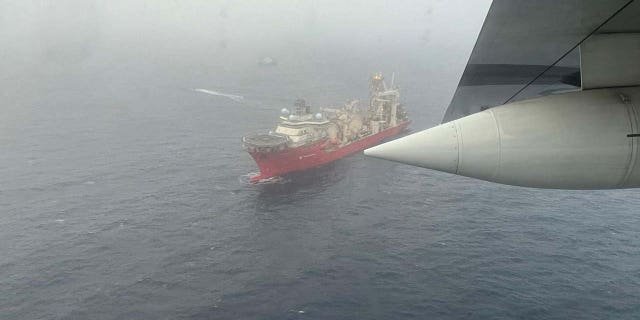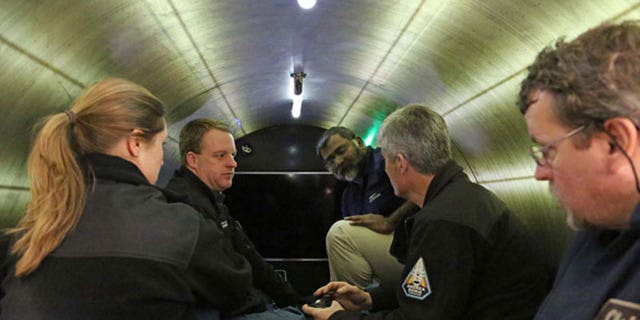As military and civilian fleets scour the Atlantic Ocean off the coast of New England and Canada for signs of the missing OceanGate Titan submersible, people around the world are hoping that sounds picked up Tuesday are evidence the international crew is still alive.
Dr. Jeff Karson, professor emeritus of earth and environmental sciences at Syracuse University, worries that efforts to triangulate the location of unidentified sounds picked up by search-and-rescue crews on Tuesday and Wednesday could take too long – and divert resources to the wrong place if the source turns out to be something other than trapped crew members banging on the hull of the ship.
“I’m worried that there are bogus sounds out there and sounds that are inadvertently drawing the search away from the area that needs to be investigated,” Karson said.
‘BANGING’ NOISES CONFIRMED IN DESPARATE DEEP-SEA SEARCH FOR MISSING TITAN SUB BUT SOURCE UNKNOWN
This file image provided by OceanGate shows the Titan submersible being launched from a platform. (OceanGate Expeditions)
Coast Guard Capt. Jamie Frederick confirmed at a Wednesday afternoon news briefing that resources were immediately deployed to try and locate the source of a sound picked up by Canadian pilots repeatedly beginning Tuesday. Despite those efforts, however, they hadn’t found the sub or the cause of the noises.
“The Coast Guard spokesman was not clear that this was banging, and I’m afraid that someone identified the sounds that way in an overly optimistic interpretation,” he said. “And the other thing I was unhappy to hear was that he didn’t wanna confirm that sound was coming at 30-minute intervals.”
I hate to say it, but they could quite likely have run out of oxygen already or be extremely low.
Carl Hartsfield, a retired Navy captain and a scientist from the Woods Hole Oceanographic Institution, said during the briefing that the noises had been “described as banging,” but authorities did not elaborate.
“I can’t tell you what the noises are,” Frederick said. “But what I can tell you, and I think that this is the most important point, is that we’re searching where the noises are.”

US Coast Guard (USCG) Captain Jamie Frederick speaks to reporters about the search efforts for the Titan submersible that went missing near the wreck of the Titanic, at Coast Guard Base in Boston, Massachusetts, on June 21, 2023. The USCG said Wednesday it had not identified the source of underwater noises detected by sonar in the search for the missing submersible. “We don’t know what they are, to be frank with you,” Frederick said regarding the sounds that had raised hopes the five people onboard are still alive. “We have to remain optimistic and hopeful when you’re in a search and rescue case,” he told reporters. (Joseph Prezioso/AFP via Getty Images)
What Frederick could tell the gathered journalists was that the number of surface vessels would double Thursday morning to 10 from the five in the area Wednesday. American and Canadian pilots have been flying around the clock, and Britain and France are also assisting the overall effort.
“This is a search-and-rescue mission, 100%,” he said.
The OceanGate Titan submersible is missing, along with five people on board: OceanGate CEO Stockton Rush; British businessman turned adventurer Hamish Harding, father-and-son Shahzada and Suleman Dawood, who are members of one of Pakistan’s wealthiest families; and Paul-Henry Nargeolet, a former French navy officer and leading Titanic expert.
“There’s a whole community of scientists like myself and engineers who are involved in deep submergence science, and everyone has just been on the edge of their seats for days and will be until this whole thing is resolved one way or another,” Karson told Fox News Digital. “This is heart-rending on one hand, and yet it’s a scientific problem on the other.”
WEATHER FORECAST FOR FINAL HOURS AS RESCUE CREWS WORK TO FIND MISSING TITANIC TOURIST SUBMERSIBLE
Karson, also an adjunct scientist at Woods Hole Oceanographic Institution, which has sent experts to assist the search-and-rescue effort, has experience exploring the ocean floor in areas twice as deep as the missing OceanGate Titan sub’s planned mission to visit the shipwrecked Titanic.

This file image provided by OceanGate shows the Titan submersible being towed in the Bahamas. (OceanGate Expeditions)
“Everybody’s thinking about how can we use the sound to find this?” he said of the exlcusive community of deep-sea scientists. “What’s the right tools? How are we going to do this? How can it get done in time to make a difference?”
He said that regardless of the nature of the “banging,” sound in general will be the key to finding the missing submersible – either through an act of the stranded crew or sonar surveying.

Hamish Harding poses for a photo during the RMS Titanic Expedition Mission 5 on Sunday, June 18, 2023. (@actionaviation/Twitter)
U.S. and Canadian planes have been deploying sonobuoys – devices dropped into the ocean to ping their surroundings, creating a network of beacons to help triangulate items of interest – hopefully the missing Titan in this case, he said.
Deep-sea remote-operated vehicles, referred to as ROVs, are also on scene, including one with the capability of dropping to depths of about 4,000 meters. The Titan sub is believed to have gone missing in waters 3,800 meters deep.

Equipment that was flown in by U.S. Air Force transport planes is loaded onto the offshore vessel Horizon Arctic, before its deployment to the search area of a missing OceanGate Expeditions submersible which had been carrying five people to explore the sunken Titanic, in the port of St. John’s, Newfoundland, Canada June 20, 2023. (REUTERS/David Hiscock)
“Sound works very much like light,” Karson said. “The closer you get to something, the more details you can see.”
So the closer to the sea floor, the clearer the picture, he said – but the tradeoff is that you also get a narrower view.
SEARCH FOR MISSING TITANIC TOURIST SUB CONTINUES IN RACE AGAINST TIME
So those assets are deployed in tandem with surface vessels using side-scanning sonar to pinpoint objects from above that can be investigated more closely, according to Dr. Manoj Mahajan, an associate professor at Stony Brook University and former Department of Defense official.
“It’s an active sonar using acoustics to map the sea floor and discover anomalous objects – like a shipwreck, a plane crash or a stranded submarine,” he told Fox News Digital. “But time is the main issue in this case.”

This image shows the Bahamian research vessel, Deep Energy helping search for the submersible Titan on Tuesday, June 20, 2023. Titan contains a crew of five, including British billionaire Hamish Harding, who were due to visit the wreck of the Titanic, the ‘unsinkable’ ship which sunk in 1912. The U.S. Coast Guard, U.S. Navy, Canadian CoastnGuard and OceanGate Expeditions have established a unified command to search for the 21-foot submersible research vessel which went missing after losing contact with the Research Vessel Polar Prince on Sunday evening. Deep Energy arrived on the scene around 7 a.m. EDT on Tuesday and began remotely operated vehicle (ROV) operations. A C-130 crew from the Air National Guard 106th also arrived on scene to continue searching around 4 p.m. EDT. (U.S. Coast Guard/Cover Images)
And time was running out Wednesday evening as the estimated air supply on the submarine dwindled to below 12 hours.
“I hate to say it, but they could quite likely have run out of oxygen already or be extremely low,” Karson said. “You can imagine that these people are stressed out to the max, hyperventilating and probably using an immense amount of oxygen.”

This file image provided by OceanGate shows people inside the Titan submersible. The image was not taken as part of the missing expedition. (OceanGate Expeditions)
On the other hand, he said, if they are calm or sleeping for extended periods, they would be using less oxygen.
“Myself, having made many trips to the seafloor in a submersible to do geology, it’s impossible not to think about these horrible what-if scenarios,” he said. “It’s not pretty, but that’s why there’s a lot of safety factors built in to these systems.”
That includes the ability to quickly drop weight and use the sub’s natural buoyancy to drift upward toward the surface, he said.

The pilot of a Royal Canadian Air Force CP-140 Aurora maritime surveillance aircraft of 14 Wing flies a search pattern for the missing OceanGate submersible, which had been carrying five people to explore the wreck of the sunken SS Titanic, in the Atlantic Ocean off Newfoundland, Canada June 20, 2023, in a still image from video. (Canadian Forces/Handout via REUTERS )
CLICK HERE TO GET THE FOX NEWS APP
“You should be able to do that with a simple turn of a wrench or something down there, but it hasn’t happened,” he said. “So that suggests something, either they’re hung up in a very complicated way or there was some massive failure down there long ago, a couple of days ago, and there’s nothing to be done.”
If the vessel is intact but stuck, he said, an ROV may be able to unstick it or help it shed weight, allowing it to float to the top in as little as two hours for a surface rescue.